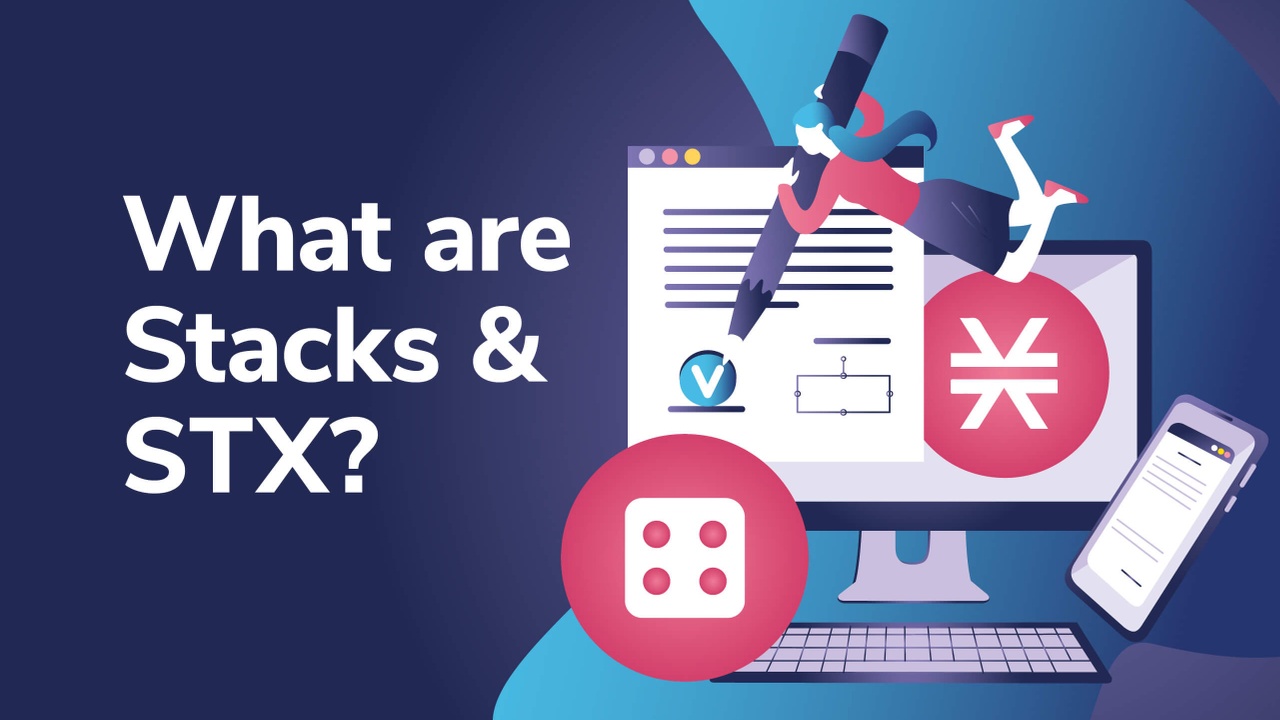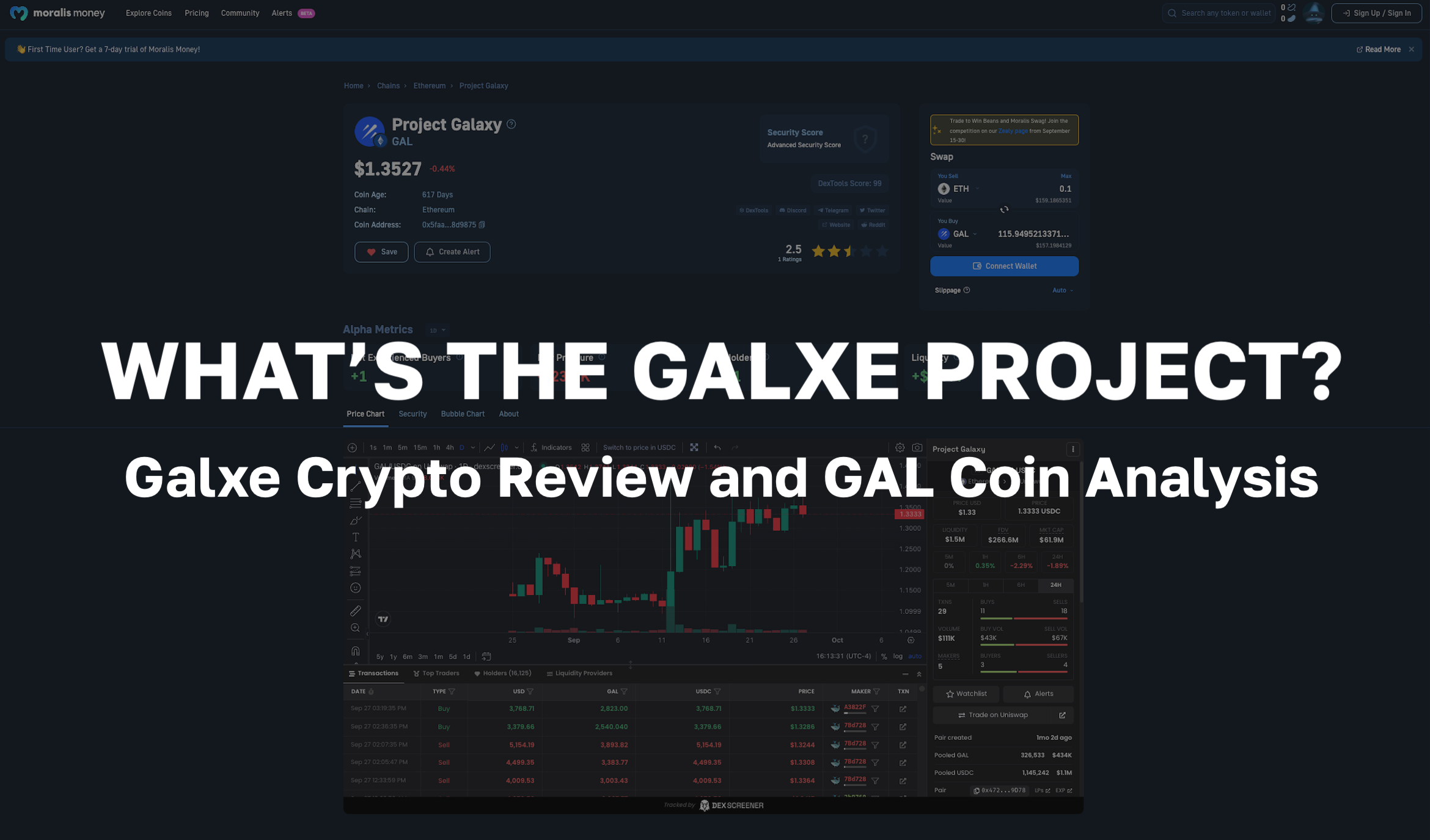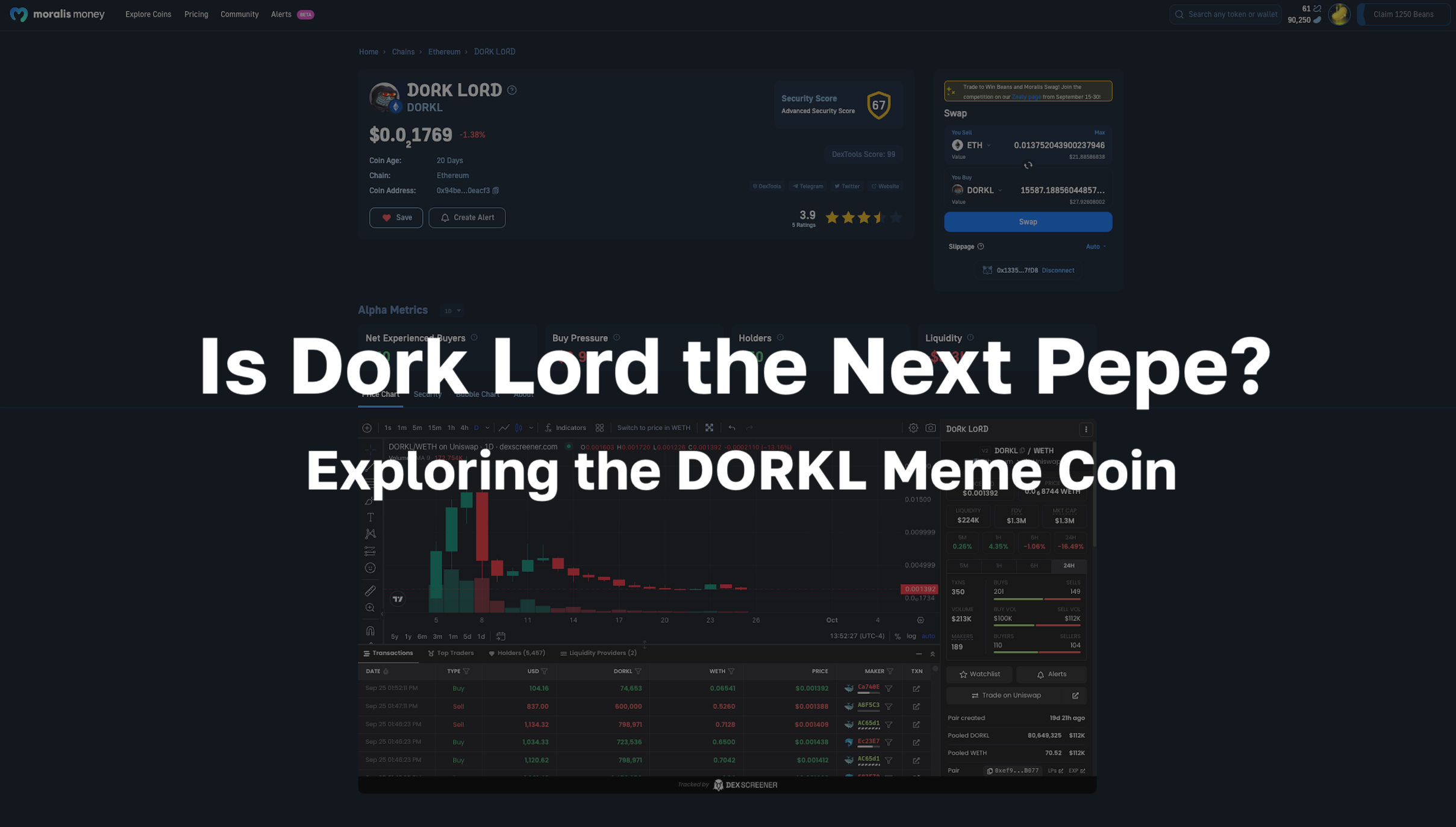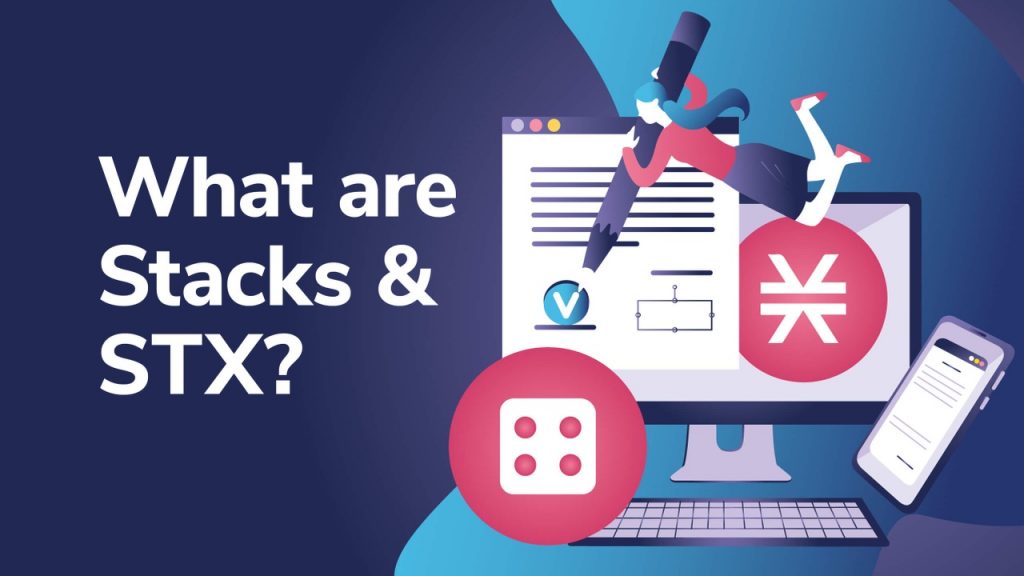
The Stacks blockchain is a custom-built, full-stack decentralized blockchain designed for the Blockstack computing network. Stacks makes Bitcoin programmable by facilitating support for decentralized applications (dApps) and smart contracts on the Bitcoin blockchain. The Stacks ecosystem harnesses the security of the Bitcoin network while bringing additional functionality to a blockchain that is notoriously challenging to build on.
The Stacks blockchain is a custom-built blockchain designed for the Blockstack network. Use of the native Stacks token (STX) in conjunction with the innovative Proof-of-Transfer (PoX) consensus mechanism provides a wealth of distributed computing opportunities for both developers and users by creating an environment that makes it simple to develop smart contracts and build dApps on Bitcoin securely, without changing the original source code.
In this article, we want to explore the Stacks blockchain and the unique opportunities it provides for its users. Also, we’re going to discuss the Stacks token (STX) and its utility across the Stacks ecosystem. Furthermore, we'll look at the Clarity smart contract programming language and how it makes it simple to build on Bitcoin!
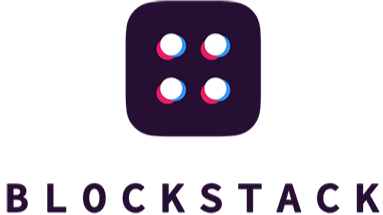
Have you ever thought about building your own decentralized applications (dApps)? If you’re new to the decentralized finance (DeFi) space, the DeFi 101 and DeFi 201 courses at Ivan on Tech Academy is the perfect place to familiarize yourself with the concepts and protocols used within DeFi. However, if you feel like getting creative, be sure to check out the Ethereum Smart Contract Programming 101 and Ethereum Smart Contract Programming 201 courses at Ivan on Tech Academy to learn how to build your own dApps and smart contracts!
What is the Stacks Blockchain?
The Stacks Blockchain is a network of open-source smart contracts and decentralized applications (dApps) that harnesses the power of the Bitcoin blockchain. Stacks is a programmable base layer that connects to the Bitcoin blockchain to unlock the full potential of the world's largest and most robust blockchain. The Stacks ecosystem is a platform for building dApps, smart contracts, and creating digital assets that benefit from both the security and the capital of the Bitcoin network.
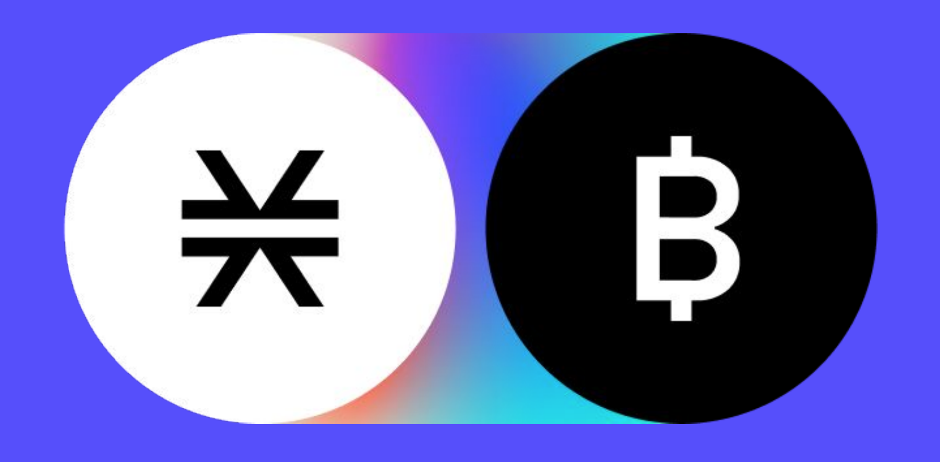
DApps can be built on the Stacks ecosystem by anyone with an internet connection. By locking up Stacks tokens (STX), users support the security and consensus of the network. As a reward, users earn Bitcoin that is transferred by Proof-of-Transfer (PoX) miners.
The Bitcoin network is completely decentralized and all transactions made on it are immutable. As such, applications built on the Stacks ecosystem also benefit from the immutability of Bitcoin settlements. Also, apps operating on the Stacks blockchain give data ownership to users, rather than holding it on centralized servers. This keeps the entire Stacks platform transparent, permissionless, and trustless.
Furthermore, decentralized apps (dApps) built on the Stacks blockchain are modular. Developers benefit from the plug-and-play facilities that allow interoperability and interconnectivity between dApps.
The technology that powers the Stacks blockchain ecosystem consists of four key components that make Stacks distributed computing possible.
Clarity Smart Contracts
A safe and predictable smart contract language that can use Bitcoin-based logic.
Stacks Blockchain
The layer-one blockchain connected to Bitcoin.
Proof-of-Transfer (PoX)
The innovative consensus mechanism that bridges Stacks with Bitcoin.
Bitcoin
Used for settlement and security, serving as the reserve asset of the Stacks ecosystem.
Stacks Ecosystem Background
Founded by Muneeb Ali and Ryan Shea, Stacks was created with the intention of building a user-owned blockchain-powered internet. The idea for Stacks began in 2013 at the Computer Science Department of Princeton University, where fellow computer scientists were recruited to join in the early stages project after a successful proposal confirmed by popular startup accelerator, Y Combinator in 2014.
After securing multiple investors, a blueprint for a blockchain-based user-owned internet was laid out in Muneeb’s 2017 Ph.D. thesis. That year, $47M was raised for an initial token offering (ICO) of the Stacks cryptocurrency. The Stacks token (STX) was the first cryptocurrency to be qualified by the Securities and Exchange Commission (SEC) for its token offering in 2019, which secured a further $23M. Over 4,500 investors participated in these token offerings. These include big names such as Blockchain Capital, Winklevoss Capital, and many others.
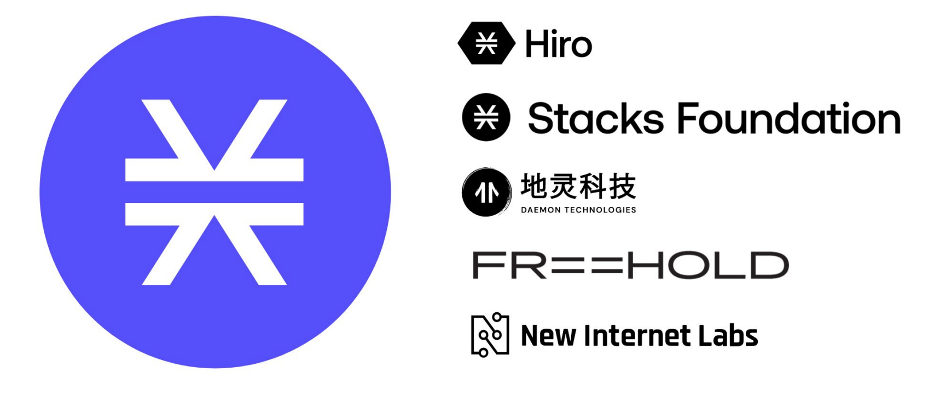
Early research and development, protocol design, and public infrastructure was carried out by Blockstack PBC following a Series A raise in 2017. Following the completion of the public infrastructure, Blockstack PBC changed its name and rebranded to ‘Hiro Systems’. Hiro Systems was established to prioritize the development of developer tools that would become the focus of Stacks 2.0.
Stacks 2.0
Launched in January 2021, the Stacks 2.0 mainnet is a hard fork from Stacks 1.0. Stacks 2.0 is considered to be an almost-entirely new project rather than an upgrade. The newly launched Stacks 2.0 was designed to address two of the most prominent drawbacks of building on Bitcoin - scalability and smart contract support. Stacks achieves this without altering the Bitcoin code while adopting the security of settlements provided by the Bitcoin network.
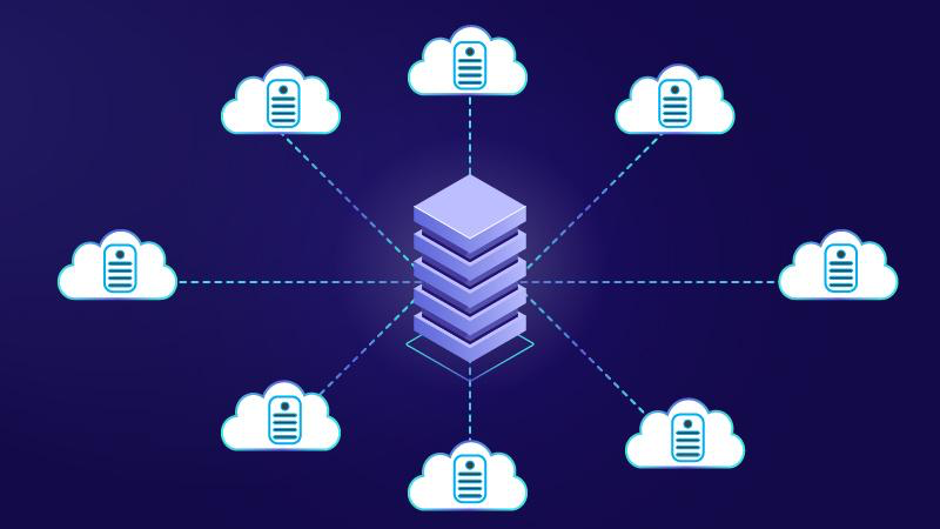
The Stacks ecosystem is host to around 400 independently built applications, all working toward a shared goal of a decentralized internet powered by Bitcoin that unlocks the power of distributed computing.
The Mission: Decentralized Distributed Computing
Distributed computing refers to a decentralized internet where everybody has control of their data, rather than any single entity. One of the disadvantages of centralized computing is its potential for censorship and de-platforming, which has become a common topic of discussion. Distributed computing allocates computational resources across a decentralized network. Therefore, there is no single point of failure, and no single entity or body can shut a platform down. This could make distributed computing a compelling prospect for future technological innovations.
The overall vision of the Stacks ecosystem is a user-owned internet built on the Bitcoin network. Furthermore, distributed computing allows users to gain ownership of their data transparently on the blockchain. Some decentralized computing projects such as Basic Attention Token (BAT) reward users in crypto tokens just for watching adverts!
Throughout 2020, Stacks worked toward increasing decentralization across the ecosystem. This resulted in several autonomous projects coming together to form the Stacks blockchain ecosystem. These projects include Daemon Technologies, New Internet Labs, Key Labs, and Stacks Foundation, and more!

Why Build on Bitcoin?
The Bitcoin network is the largest and most powerful computing network on the planet. This provides a secure and robust settlement layer for the Stacks network. Without modifying the Bitcoin design, Stacks settles transactions on each block of the Bitcoin blockchain, using Bitcoin as its reserve asset. Therefore, all transactions made using Stacks benefit from the finality of Bitcoin settlements, which users can verify on the Bitcoin blockchain.
Building on top of Bitcoin for decentralized finance (DeFi) has been challenging for developers. Bitcoin uses the “Script” coding language. Script can be limiting. The security of the Bitcoin network is dependent on these limitations to protect from an attack on the network. Scaling and implementing new features to the Bitcoin network has been a historically difficult task as a result.
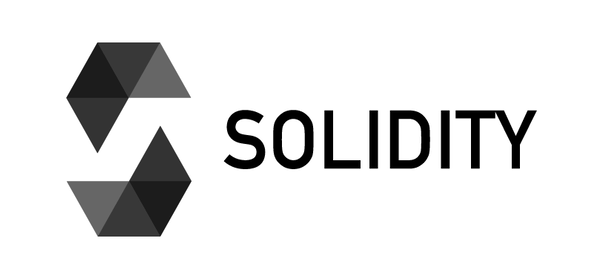
One of the reasons behind Ethereum’s increasing adoption is the programming language “Solidity”. Solidity allows money to be programmed with great flexibility and scalability. However, this is where Stacks comes in. Thanks to the Proof-of-Transfer (PoX) consensus mechanism, microblocks, and Clarity, Stacks creates an environment where developers can build decentralized financial products on the Bitcoin blockchain without making any changes to the Bitcoin code.
Blockchain technology is among the most revolutionary and disruptive innovations of a generation. By reshaping the landscape of global finance and technology, Bitcoin and blockchain are positioned at the forefront of a new economic paradigm. If you want to learn about the history of money, where we could be heading, and how blockchain is changing how we look at currency, be sure to check out the Blockchain & Bitcoin 101 and The Bitcoin Standard courses at Ivan on Tech Academy!
Proof-of-Transfer (PoX)
Bitcoin uses the Proof-of-Work consensus mechanism for mining. However, the consensus mechanism that connects Stacks with Bitcoin is known as Proof-of-Transfer (PoX). PoX provides a fresh perspective on Proof-of-Stake (PoS) consensus. A PoX chain creates new opportunities for developers to build on Bitcoin in ways never seen before.
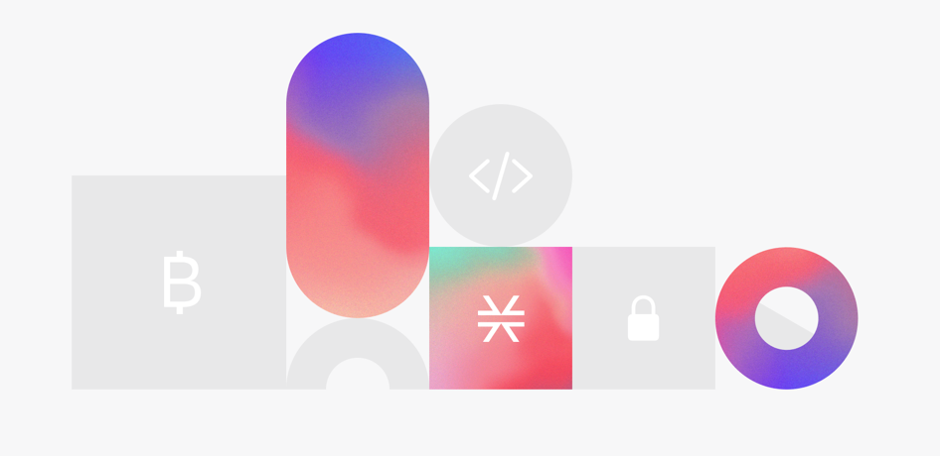
Any transaction made using Stacks is settled on the Bitcoin blockchain. Therefore, all Stacks transactions benefit from the security of the Bitcoin network. This is because all Stacks transactions are hashed into batches on the Bitcoin blockchain with each block.
Proof-of-Transfer has three core benefits.
- The entire Stacks ecosystem and the dApps within it benefit from the security of Bitcoin settlements.
- Stacks applications also benefit by being able to interact with on-chain data and state derived from the Bitcoin blockchain.
- Being a Proof-of-Transfer miner requires no expensive hardware, meaning that anyone with an internet connection can become a PoX miner!
Rather than using computational power and electricity, Proof-of-Transfer miners earn block rewards and transaction fees by transferring Bitcoin to STX token holders. As a result, STX token holders earn Bitcoin through PoX consensus mining in a process known as ‘Stacking’.
How does the Stacks Blockchain Work?
The Stacks blockchain is “a flexible layer on top of Bitcoin that enables decentralized apps, smart contracts, and digital assets”. Furthermore, the Stacks blockchain is a layer-one blockchain, just like Bitcoin. However, the Stacks blockchain is more malleable than the Bitcoin blockchain, as it supports additional functionality for decentralized applications (dApps) and smart contracts. Also, the block confirmation time on the Bitcoin network can hinder dApp development.
Stacks addresses this using ‘microblocks’. Microblocks enable ultra-fast transaction confirmations to occur on the Stacks blockchain, before being settled and finalized on the Bitcoin blockchain in batches with each Bitcoin block mined.
Moreover, the Stacks blockchain can scale independently from the Bitcoin blockchain. This means it is not held back by the robust architecture that has slowed the development of decentralized applications (dApps) on the Bitcoin blockchain in the past. This allows Stacks to create dApps that benefit from the security and settlement of Bitcoin, with transaction times that can compete with faster blockchains!
Stacks Token (STX)
The native Stacks Token (STX) is used for paying all transaction fees across the Stack blockchain. STX works as the fuel of the Stacks blockchain ecosystem. This includes the costs of executing smart contracts and the creation of digital assets. Also, Stacks token holders can earn Bitcoin rewards by locking up their STX to participate in the PoX consensus.
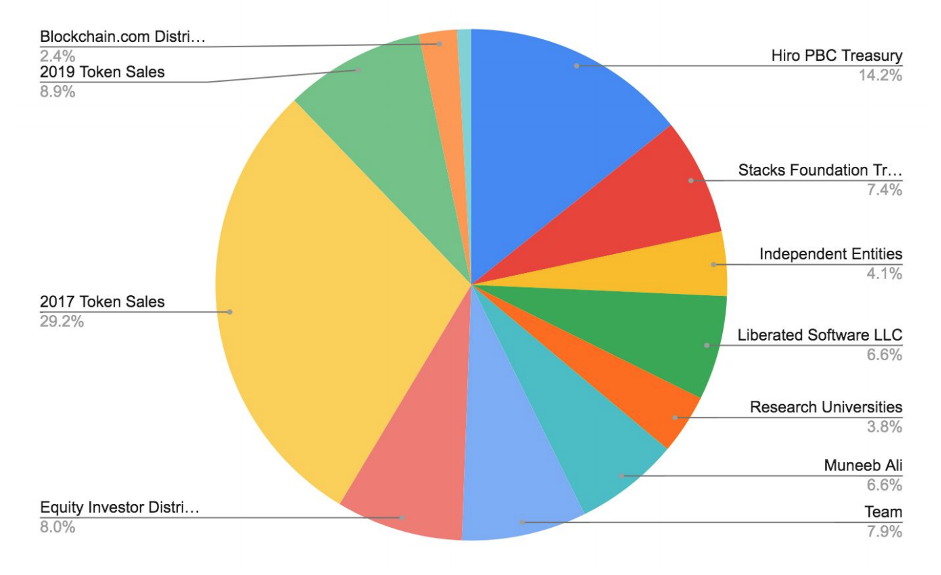
The value of the Stacks token (STX) is determined by the growth and demand of the network, as the main utility of the STX token is for smart contract interaction and transaction fees, or ‘fuel’, which is similar to gas on Ethereum.
At the time of writing, the Stacks token (STX) is trading at around $0.46, with a market cap of $423,571,018. STX has a circulating supply of 918,007,935, with a technically uncapped max supply. However, the Stacks cryptocurrency has a predefined future supply that will reach approximately 1.8 billion STX by 2050.
Stacking
Not only is the Stacks token (STX) used for transactions on the Stacks blockchain, but STX holders can also earn Bitcoin from a process called ‘stacking’. Stacking involves locking up STX tokens for a specified period. During this period, users are unable to access their funds. However, the Proof-of-Transfer (PoX) consensus mechanism requires Bitcoin miners to distribute BTC rewards to stackers periodically for locking up their funds and contributing to the security of the network. This allows Stacks token holders to earn a passive income with crypto!
To participate in stacking, holders of the Stacks token (STX) operate a full node. Node operators are required to lock up their STX and broadcast data to the network. Stacking works in cycles. Stackers decide how many cycles they want to lock their funds up for and receive rewards when the cycles end and the STX tokens are unlocked. The target duration for the cycles is around two weeks. However, this is based on the block time of the Bitcoin network and can therefore result in fluctuations.
The Proof-of-Transfer (PoX) consensus mechanism creates a unique STX and BTC exchange pair that enables stackers to earn rewards in Bitcoin for securing the Stacks blockchain. This is distinct from many other staking mechanisms whereby rewards are usually paid out in the currency staked.
Clarity
Clarity is a new open-source project and smart contract programming language designed to bring DeFi to Bitcoin. The Clarity programming language is interpreted, i.e. not compiled, and all source code is published publicly on the blockchain. Moreover, Clarity makes it easy for developers to build complex and nuanced smart contracts that operate on the Bitcoin blockchain.
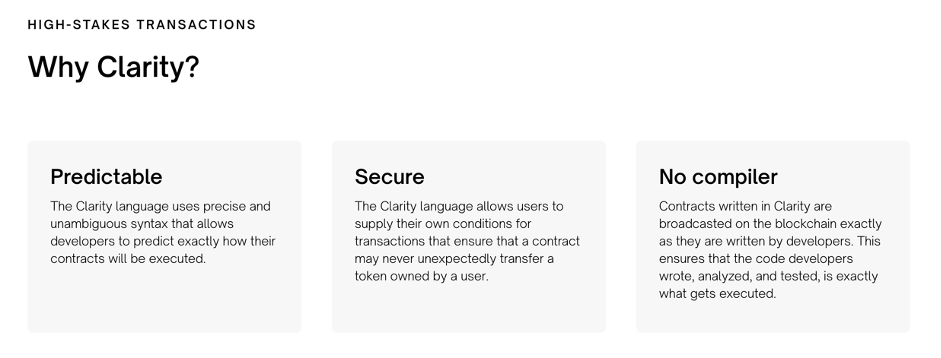
The Clarity language utilizes a predictable syntax to enable developers to reliably predict the outcome of each smart contract executed. Furthermore, users can implement personalized conditions for smart contract transactions. Smart contracts can be broadcast just as they were written, with no compiler. This enables developers to test smart contracts with confidence in their authenticity, as only code written and tested in Clarity is executed with Clarity smart contracts.
Clarity is described as “a safe and predictable language for smart contracts”. Clarity smart contracts utilize Bitcoin-based logic and state while adding additional versatility. Using a simple Web 3.0 interface, Clarity enables less-technical developers to create reliable smart contracts they can trust.
Furthermore, Clarity is optimized for security. Many smart contract programming languages have a large capacity for malicious actors and bugs. This can cause irreparable damage to a smart-contract-based protocol if a bug is used in the code. Clarity reduces the surface area that malicious actors and bad code can operate within. Hence, it becomes difficult to create dangerous or malicious code for smart contracts.
With built-in Simplified Payment Verification (SPV) proofs, Clarity has clear visibility into the Bitcoin chain state. This makes it simple to use Bitcoin-based logic when programming smart contracts and decentralized applications (dApps) for distributed computing services.
Clarity is a single programming language with no compiler that requires no assembly or bytecode. Furthermore, Clarity is decidable and Turing-incomplete, making it a familiar user experience for many programmers.
Stacks Foundation
Stacks Foundation is responsible for the governance of the Stacks blockchain ecosystem. Also, Stacks Foundation considers many proposals and distributes grants to developers to build on the Stacks blockchain.

Furthermore, the Stacks Foundation Grants Program provides funding for builders with a shared goal of creating a decentralized internet, facilitated by decentralized applications (dApps) and developer tools built on the Stacks blockchain.
Stacks Blockchain & STX Token Summary
Decentralized finance (DeFi) is one of the hottest trends in crypto right now. As such, it only makes sense that Bitcoin should join the party. The Stacks blockchain is changing how cryptocurrency is used by bringing the benefits of Bitcoin to DeFi to create a better internet for everyone.
Blockchain is becoming an essential tool across major industries including healthcare, fashion, and supply chain management. Also, blockchain is assisting in the development of decentralized social media platforms. Stacks is one of many cryptocurrency projects aiming to democratize data and make the internet a better place for everyone by harnessing the power of the Bitcoin blockchain to make it simple for programmers to build decentralized applications (dApps) on Bitcoin.
Blockchain programmers are in extremely high demand. With such specialized skills, blockchain programmers command a handsome salary and gain an early foot-in-the-door of a rapidly growing industry. The JavaScript Programming for Blockchain Developers and C++ Programming for Blockchain courses at Ivan on Tech Academy are designed to get you where you need to be to find your perfect job in crypto! Regardless of experience, Ivan on Tech Academy has courses that are designed to help you streamline your success in crypto! Also, if you’re using Stacks already, follow us on Twitter @Academy_IOT and let us know what you’re building!
